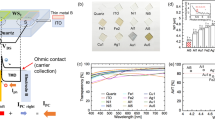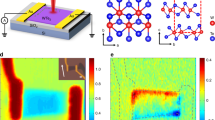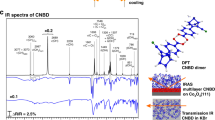Abstract
The photovoltaic effect in traditional p–n junctions—where a p-type material (with an excess of holes) abuts an n-type material (with an excess of electrons)—involves the light-induced creation of electron–hole pairs and their subsequent separation, generating a current. This photovoltaic effect is particularly important for environmentally benign energy harvesting, and its efficiency has been increased dramatically, almost reaching the theoretical limit1. Further progress is anticipated by making use of the bulk photovoltaic effect (BPVE)2, which does not require a junction and occurs only in crystals with broken inversion symmetry3. However, the practical implementation of the BPVE is hampered by its low efficiency in existing materials4,5,6,7,8,9,10. Semiconductors with reduced dimensionality2 or a smaller bandgap4,5 have been suggested to be more efficient. Transition-metal dichalcogenides (TMDs) are exemplary small-bandgap, two-dimensional semiconductors11,12 in which various effects have been observed by breaking the inversion symmetry inherent in their bulk crystals13,14,15, but the BPVE has not been investigated. Here we report the discovery of the BPVE in devices based on tungsten disulfide, a member of the TMD family. We find that systematically reducing the crystal symmetry beyond mere broken inversion symmetry—moving from a two-dimensional monolayer to a nanotube with polar properties—greatly enhances the BPVE. The photocurrent density thus generated is orders of magnitude larger than that of other BPVE materials. Our findings highlight not only the potential of TMD-based nanomaterials, but also more generally the importance of crystal symmetry reduction in enhancing the efficiency of converting solar to electric power.
This is a preview of subscription content, access via your institution
Access options
Access Nature and 54 other Nature Portfolio journals
Get Nature+, our best-value online-access subscription
$29.99 / 30 days
cancel any time
Subscribe to this journal
Receive 51 print issues and online access
$199.00 per year
only $3.90 per issue
Buy this article
- Purchase on Springer Link
- Instant access to full article PDF
Prices may be subject to local taxes which are calculated during checkout




Similar content being viewed by others
Data availability
The data that support the findings of this study are available from the corresponding author upon reasonable request.
References
Shockley, W. The theory of p–n junctions in semiconductors and p–n junction transistors. ATT Tech. J. 28, 435–489 (1949).
Cook, A. M., Fregoso, B. M., de Juan, F., Coh, S. & Moore, J. E. Design principles for shift current photovoltaics. Nat. Commun. 8, 14176 (2017).
Sturman, B. I. & Fridkin, V. M. The Photovoltaic and Photorefractive Effects in Noncentrosymmetric Materials (Gordon and Breach Science Publishers, 1992).
Grinberg, I. et al. Perovskite oxides for visible-light-absorbing ferroelectric and photovoltaic materials. Nature 503, 509–512 (2013).
Nakamura, M. et al. Shift current photovoltaic effect in a ferroelectric charge-transfer complex. Nat. Commun. 8, 281 (2017).
Brody, P. S. High-voltage photovoltaic effect in barium-titanate and lead titanate lead zirconate ceramics. J. Solid State Chem. 12, 193–200 (1975).
Yang, S. Y. et al. Above-bandgap voltages from ferroelectric photovoltaic devices. Nat. Nanotechnol. 5, 143–147 (2010).
Xiao, Z. G. et al. Giant switchable photovoltaic effect in organometal trihalide perovskite devices. Nat. Mater. 14, 193–198 (2015).
Sun, Z. H. et al. A photoferroelectric perovskite-type organometallic halide with exceptional anisotropy of bulk photovoltaic effects. Angew. Chem. Int. Edn 55, 6545–6550 (2016).
Nechache, R. et al. Photovoltaic properties of Bi2FeCrO6 epitaxial thin films. Appl. Phys. Lett. 98, 202902 (2011).
Wilson, J. A. & Yoffe, A. D. Transition metal dichalcogenides discussion and interpretation of observed optical, electrical and structural properties. Adv. Phys. 18, 193–335 (1969).
Zeng, H. L. et al. Optical signature of symmetry variations and spin-valley coupling in atomically thin tungsten dichalcogenides. Sci. Rep. 3, 1608 (2013).
Xiao, D., Liu, G. B., Feng, W. X., Xu, X. D. & Yao, W. Coupled spin and valley physics in monolayers of MoS2 and other group-VI dichalcogenides. Phys. Rev. Lett. 108, 196802 (2012).
Zhang, Y. J., Oka, T., Suzuki, R., Ye, J. T. & Iwasa, Y. Electrically switchable chiral light-emitting transistor. Science 344, 725–728 (2014).
Wu, W. Z. et al. Piezoelectricity of single-atomic-layer MoS2 for energy conversion and piezotronics. Nature 514, 470–474 (2014).
Tenne, R., Margulis, L., Genut, M. & Hodes, G. Polyhedral and cylindrical structures of tungsten disulfide. Nature 360, 444–446 (1992).
Zak, A. et al. Scaling up of the WS2 nanotubes synthesis. Fuller. Nanotub. Carbon Nanostruct. 19, 18–26 (2010).
Zhang, C. et al. High-performance photodetectors for visible and near-infrared lights based on individual WS2 nanotubes. Appl. Phys. Lett. 100, 243101 (2012).
Qin, F. et al. Superconductivity in a chiral nanotube. Nat. Commun. 8, 14465 (2017).
Yadgarov, L. et al. Strong light–matter interaction in tungsten disulfide nanotubes. Phys. Chem. Chem. Phys. 20, 20812–20820 (2018).
Yuan, H. T. et al. Generation and electric control of spin-valley-coupled circular photogalvanic current in WSe2. Nat. Nanotechnol. 9, 851–857 (2014).
Freitag, M., Low, T., Xia, F. N. & Avouris, P. Photoconductivity of biased graphene. Nat. Photon. 7, 53–59 (2013).
Quereda, J. et al. Symmetry regimes for circular photocurrents in monolayer MoSe2. Nat. Commun. 9, 3346 (2018).
Tauc, J. Generation of an emf in semiconductors with nonequilibrium current carrier concentrations. Rev. Mod. Phys. 29, 308–324 (1957).
Yang, M. M., Kim, D. J. & Alexe, M. Flexo-photovoltaic effect. Science 360, 904–907 (2018).
Yuan, Y. B., Xiao, Z. G., Yang, B. & Huang, J. S. Arising applications of ferroelectric materials in photovoltaic devices. J. Mater. Chem. A Mater. Energy Sustain. 2, 6027–6041 (2014).
Morimoto, T. & Nagaosa, N. Topological nature of nonlinear optical effects in solids. Sci. Adv. 2, e1501524 (2016).
Morimoto, T. & Nagaosa, N. Topological aspects of nonlinear excitonic processes in noncentrosymmetric crystals. Phys. Rev. B 94, 035117 (2016).
Fregoso, B. M., Morimoto, T. & Moore, J. E. Quantitative relationship between polarization differences and the zone-averaged shift photocurrent. Phys. Rev. B 96, 075421 (2017).
Rangel, T. et al. Large bulk photovoltaic effect and spontaneous polarization of single-layer monochalcogenides. Phys. Rev. Lett. 119, 067402 (2017).
Nakhmanson, S. M., Calzolari, A., Meunier, V., Bernholc, J. & Nardelli, M. B. Spontaneous polarization and piezoelectricity in boron nitride nanotubes. Phys. Rev. B 67, 235406 (2003).
Král, P., Mele, E. J. & Tomanek, D. Photogalvanic effects in heteropolar nanotubes. Phys. Rev. Lett. 85, 1512–1515 (2000).
Pearce, A. J., Mariani, E. & Burkard, G. Tight-binding approach to strain and curvature in monolayer transition-metal dichalcogenides. Phys. Rev. B 94, 155416 (2016).
Shi, W. et al. Superconductivity series in transition metal dichalcogenides by ionic gating. Sci. Rep. 5, 11534 (2015).
Zhang, Y. J. et al. Optoelectronic response of a WS2 tubular p–n junction. 2D Mater. 5, 035002 (2018).
Bar Sadan, M., Houben, L., Enyashin, A. N., Seifert, G. & Tenne, R. Atom by atom: HRTEM insights into inorganic nanotubes and fullerene-like structures. Proc. Natl Acad. Sci. USA 105, 15643–15648 (2008).
Chen, Y. H., Deniz, H. K. & Qin, L. C. Accurate measurement of the chirality of WS2 nanotubes. Nanoscale 9, 7124–7134 (2017).
Alon, O. E. Symmetry properties of single-walled boron nitride nanotubes. Phys. Rev. B 64, 153408 (2001).
Ghorbani-Asl, M. et al. Electromechanics in MoS2 and WS2: nanotubes vs. monolayers. Sci. Rep. 3, 2961 (2013).
Bernardi, M., Palummo, M. & Grossman, J. C. Extraordinary sunlight absorption and one-nanometer-thick photovoltaics using two-dimensional monolayer materials. Nano Lett. 13, 3664–3670 (2013).
Seeger, K. Semiconductor Physics: An Introduction 2nd edn (Springer-Verlag, 1982).
O’Donnell, K. P. & Chen, X. Temperature dependence of semiconductor band-gaps. Appl. Phys. Lett. 58, 2924–2926 (1991).
He, Z. Y. et al. Layer-dependent modulation of tungsten disulfide photoluminescence by lateral electric fields. ACS Nano 9, 2740–2748 (2015).
Braga, D., Lezama, I. G., Berger, H. & Morpurgo, A. F. Quantitative determination of the band gap of WS2 with ambipolar ionic liquid-gated transistors. Nano Lett. 12, 5218–5223 (2012).
Trousil, Z. Bulk photo-voltaic phenomenon. Czech. J. Phys. 6, 96–98 (1956).
Frank, H. Lichtelelektrische Messung des inneren elektrischen Feldes in inhomogenen Halbleitern. Czech. J. Phys. 6, 433–441 (1956).
Ichiki, M. et al. Photovoltaic effect of lead lanthanum zirconate titanate in a layered film structure design. Appl. Phys. Lett. 84, 395–397 (2004).
Cao, D. W. et al. High-efficiency ferroelectric-film solar cells with an n-type Cu2O cathode buffer layer. Nano Lett. 12, 2803–2809 (2012).
Zenkevich, A. et al. Giant bulk photovoltaic effect in thin ferroelectric BaTiO3 films. Phys. Rev. B 90, 161409 (2014).
Alexe, M. & Hesse, D. Tip-enhanced photovoltaic effects in bismuth ferrite. Nat. Commun. 2, 256 (2011).
Zak, A., Sallacan-Ecker, L., Margolin, A., Genut, M. & Tenne, R. Insight into the growth mechanism of WS2 nanotubes in the scaled-up fluidized-bed reactor. Nano 4, 91–98 (2009).
Acknowledgements
We thank M. Kuehne, H. Isobe, M. Nakamura, N. Ogawa and D. Zhao for discussions; S. Göres Y. Stuhlhofer, J. Geurs and Y. Kim for technical assistance; and A. Oiwa, B. Zhang, K. von Klitzing, Y. Tokura, M. Kawasaki and N. Nagaosa for suggestions. We acknowledge financial support from the Japan Society for the Promotion of Science (to Y.J.Z., M.O. and R.S. through the research fellowship program for young scientists; M.O. through the Advanced Leading Graduate Course for Photon Science; T.I. through the Challenging Research (Exploratory) (no. JP17K18748), the ‘Topological Materials Science’ (no. JP18H04216) KAKENHI on Innovative Areas, and Scientific Research (B) (no. JP19H01819); and Y.I. through a grant-in-aid for specially promoted research (no. 25000003) and Scientific Research (A) (no. JP19H00653)). We also acknowledge financial support from the Israel Science Foundation (ISF; to A.Z. and R.T.; no. 330/16 and 339/18); the Pazy Foundation of Israel (to A.Z.); the H. Perlman and the Irving and Azelle Waltcher Foundations in honour of M. Levy (to R.T.); the H. Perlman family foundation (to R.T.; no. 720821); and the Graphene Flagship (to J.H.S.).
Author information
Authors and Affiliations
Contributions
R.S. synthesized single crystals of WS2. A.Z. synthesized and characterized WS2 nanotubes, including carrying out X-ray diffraction and TEM measurements. Y.J.Z., M.O., F.Q. and R.S. fabricated devices and performed photovoltaic response measurements. Y.J.Z. performed SKPM measurements. Y.J.Z., T.I., A.Z., R.T., J.H.S. and Y.I. were the main writers of the manuscript. All authors contributed to improving the manuscript.
Corresponding author
Ethics declarations
Competing interests
The authors declare no competing interests.
Additional information
Publisher’s note: Springer Nature remains neutral with regard to jurisdictional claims in published maps and institutional affiliations.
Extended data figures and tables
Extended Data Fig. 1 Characterization of WS2 nanotube devices.
a, The black trace shows the results of an X-ray diffraction analysis of a WS2 nanotube. The red bars indicate the simulated peak positions for a 2H-type bulk WS2 material. The small shift in the (002), (004) and (006) peaks for the WS2 nanotube is also consistent with previous work51 indicating that the distance between layers in the nanotubes is slightly larger than that in bulk WS2. b, Electron-diffraction pattern for a WS2 nanotube. White and blue hexagons have been included to indicate the differing chirality of each layer making up the nanotube wall19. The white scale bar represents 5 nm−1. The red arrow marks the orientation of the nanotube, as determined from the TEM image in the inset (black scale bar, 50 nm). c, Colour rendition of the height map recorded by AFM on devices 1 and 2. Scale bars represent 4 µm. d, Height profiles of both tubes along the dashed lines in panel c. The horizontal axis (x) represents the position along these lines. The diameter of the first nanotube (device 1) is 180 nm; for device 2, the diameter is 90 nm. a and b are adapted from ref. 19.
Extended Data Fig. 2 Photovoltaic response of WS2 nanotube device 2.
a, Dependence of Isc on the position of the laser spot. The scale bar in the optical micrograph of the device represents 4 µm. The horizontal axis (x) shows the distance between the laser spot and one of the electrodes (see optical micrograph, inset). b, DC I–V characteristics in the dark at voltages up to ±1 V.
Extended Data Fig. 3 Effect of oblique incidence of the laser light on the photocurrent response of a WS2 nanotube device.
a, Illustration of the oblique incidence condition in WS2 nanotubes. b, Dependence of the photocurrent on the polarization characteristics of the incident laser beam.
Extended Data Fig. 4 AFM and SKPM of WS2 nanotubes, and influence of domain number and size on the net Dember photovoltaic effect.
a, Colour rendition of a height map recorded by AFM in the dark. The scale bar represents 2 µm. b, Greyscale map of the surface potential recorded with a scanning Kelvin probe microscope in the dark. The scanned area is identical to that in a. The sample contacts are both connected to ground during the measurement. c, Line scans of the surface potential along three different WS2 nanotubes. d, Expected spatial dependence of the photovoltaic signal caused by the Dember effect for three different domain configurations. Domains with different electrical characteristics are coloured differently and marked with δ+ (dark green) or δ− (light green).
Extended Data Fig. 5 The BPVE in various materials.
The short-circuit current density, jsc, is plotted against laser power for bulk ferroelectric materials and WS2 nanotubes. Filled symbols are used for data points obtained in a lateral device configuration, whereas open symbols refer to data points obtained on other, vertical device geometries. References are as follows: KBNNO4; TTF-CA5; Pb(ZrTi)O3, lateral6, vertical47, contact with copper oxide48; BaTiO3, lateral6, vertical49; BiFeO3, lateral7, tip enhancement50; MaPbI3, lateral and vertical8; organometallic perovskite halide9; BFCO10.
Extended Data Fig. 6 Photovoltaic response of WS2 nanotube device 2 under uniform illumination.
The laser wavelength was 532 nm. a, I–V characteristics recorded with a ×10 objective. b, Dependence of Isc on the linear polarization angle of the incident laser beam. c, Laser power dependence of Isc. The dashed lines correspond to a linear and a square-root power dependence and serve as guides to the eye. d, Temperature dependence of Voc. The laser power density was set to 8.29 × 102 W cm−2 for a, b and d. The data in a–c were recorded at 300 K.
Extended Data Fig. 7 Lock-in measurements of the BPVE in WS2 nanotube device 2.
The incident laser beam was periodically modulated at a frequency of 133 Hz with the help of a chopper. The excitation wavelength and laser power were 632.8 nm and 6.32 × 103 W cm−2, respectively. a, Dependence of Isc on the position of the laser spot. The scale bar in the optical micrograph of the device represents 4 µm. Both magnitude and phase are plotted. The horizontal axis (x) is the distance between the laser spot and one of the electrodes (see optical micrograph). b, Dependence of the photocurrent on the linear polarization angle of the incident laser beam. The thick black arrows at the centre of the polar diagrams mark the orientation of the nanotube. c, Magnitude and phase of the AC photocurrent as a function of the applied voltage.
Rights and permissions
About this article
Cite this article
Zhang, Y.J., Ideue, T., Onga, M. et al. Enhanced intrinsic photovoltaic effect in tungsten disulfide nanotubes. Nature 570, 349–353 (2019). https://doi.org/10.1038/s41586-019-1303-3
Received:
Accepted:
Published:
Issue Date:
DOI: https://doi.org/10.1038/s41586-019-1303-3
This article is cited by
-
The gold ticket to achiral WS2 nanotubes
Nature Materials (2024)
-
Direct growth of single-chiral-angle tungsten disulfide nanotubes using gold nanoparticle catalysts
Nature Materials (2024)
-
Giant intrinsic photovoltaic effect in one-dimensional van der Waals grain boundaries
Nature Communications (2024)
-
Disorder-induced bulk photovoltaic effect in a centrosymmetric van der Waals material
npj 2D Materials and Applications (2023)
-
Berry curvature dipole generation and helicity-to-spin conversion at symmetry-mismatched heterointerfaces
Nature Nanotechnology (2023)
Comments
By submitting a comment you agree to abide by our Terms and Community Guidelines. If you find something abusive or that does not comply with our terms or guidelines please flag it as inappropriate.



